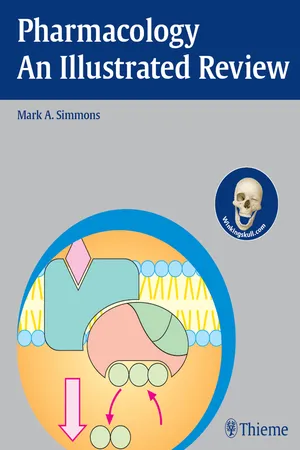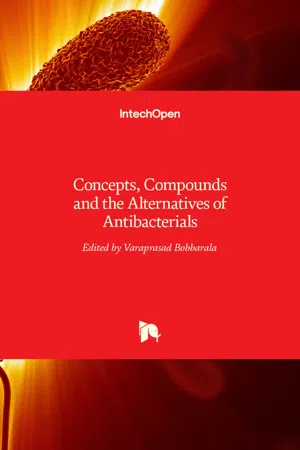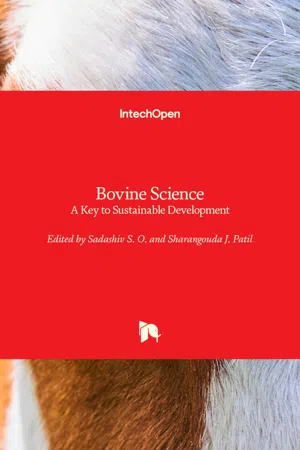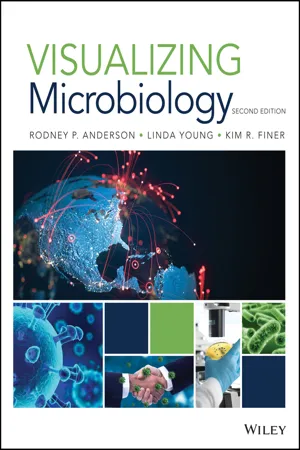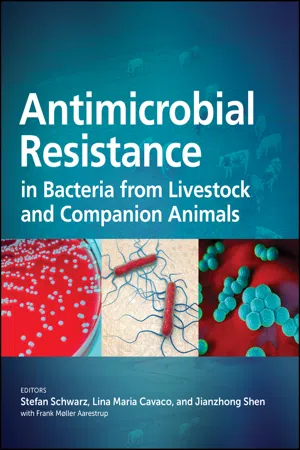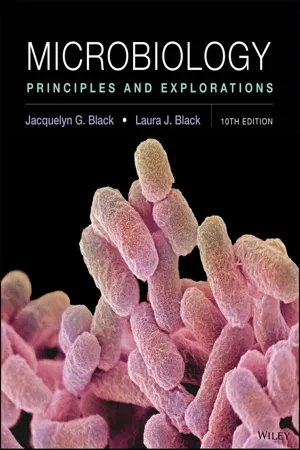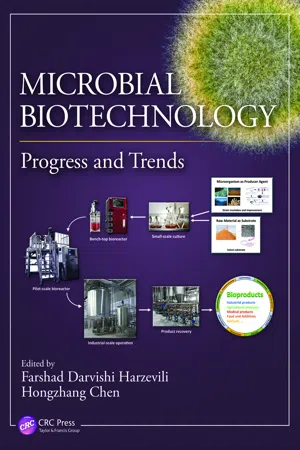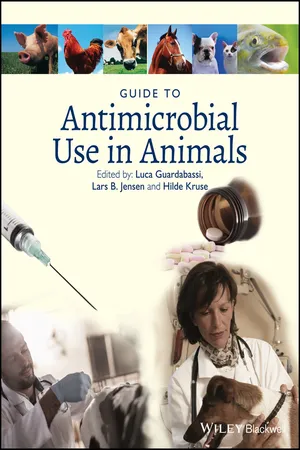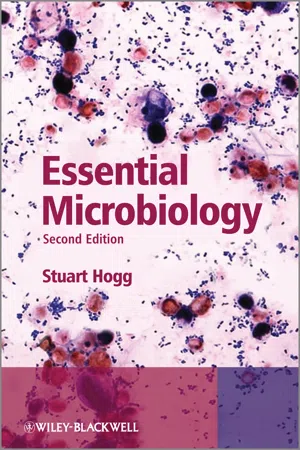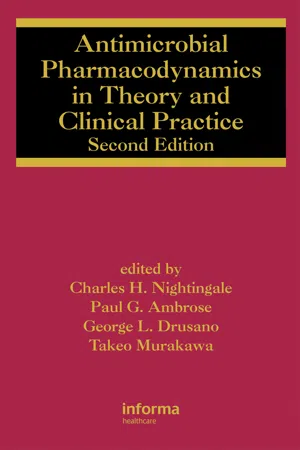Biological Sciences
Antimicrobials
Antimicrobials are substances that can kill or inhibit the growth of microorganisms such as bacteria, viruses, fungi, and parasites. They are used to treat infections in humans, animals, and plants. Antimicrobials can be natural or synthetic and are a critical tool in combating infectious diseases and maintaining public health.
Written by Perlego with AI-assistance
Related key terms
1 of 5
11 Key excerpts on "Antimicrobials"
- eBook - PDF
- Mark A. Simmons(Author)
- 2011(Publication Date)
- Thieme(Publisher)
281 28 Principles of Antimicrobial Therapy 28 Principles of Antimicrobial Therapy Infectious diseases are caused by microbes or by microbial products. Antimicrobial drugs are intended to eliminate foreign organisms or abnormal cells from healthy tissues of the patient without comparable effects on the normal tissue cells of the host. This essential property of these drugs is called selective toxicity. 28.1 Classification of Antimicrobial Agents Chemical Structure and Mechanism of Action The main classification of antimicrobial agents is based on chemical structure (e.g., β-lactams and aminoglycosides) and mechanism of action (see Table 28.1 ). Table 28.1 ▶ Mechanism of Action of Antimicrobial Agents Mechanism of Action Drugs Inhibition of bacterial cell wall synthesis β-lactams: penicillins, cephalosporins, and carbapenems Others: cycloserine, vancomycin, and bacitracin Reversible inhibition of protein synthesis by disrupt-ing the function of 30S or 50S ribosomal subunits Bacteriostatic: chloramphenicol, tetracyclines, erythromycin, clindamycin, streptogramins, and linezolid Bactericidal: aminoglycosides Inhibition of nucleic acid metabolism by inhibiting RNA polymerase Rifampin and rifabutin Inhibition of nucleic acid metabolism by inhibiting DNA gyrase or topoisomerase The quinolones Inhibition of essential enzymes of folate metabo -lism (antimetabolites) Trimethoprim and sulfonamides Bacteriostatic or Bactericidal Antimicrobial agents are also classified according to whether they are bacteriostatic or bacte-ricidal ( Fig. 28.1 ). Fig. 28.1 ▶ Bacteriostatic versus bactericidal antibacterial agents. Bacteria are able to multiply in vitro in a growth medium if conditions are favorable. If the growth medium contains an antibiotic, the bacteria may be killed (bactericidal effect), or the bacteria may survive but are unable to multiple (bacteriostatic effect). 1 day Antibiotic Bacteriostatic Bactericidal - Varaprasad Bobbarala(Author)
- 2015(Publication Date)
- IntechOpen(Publisher)
The existing Antimicrobials in the clinical investigations have provided an array of choices when treating many types of infectious diseases. However, treatment options for patients are limited because the bacterial resistance © 2015 The Author(s). Licensee InTech. This chapter is distributed under the terms of the Creative Commons Attribution License (http://creativecommons.org/licenses/by/3.0), which permits unrestricted use, distribution, and reproduction in any medium, provided the original work is properly cited. evolved more rapidly than the antibacterial drug development. Clinical results are reporting increasing rates of in vitro resistance among previously susceptible organisms and the occurrence of intrinsically resistant microorganisms as pathogens in immunocompro‐ mised hosts [2, 3]. To reduce the development and spread of antimicrobial resistance, the preservation of current Antimicrobials through their appropriate use becomes mandatory. This motivates scientists to focus on discovery and production of new chemical substan‐ ces that destroy pathogenic microorganisms with minimal damage to host tissues [4]. Thus, the design of novel classes of antibacterial drugs is redirected on synthesis of compounds with a completely novel mechanism of action [5]. For a deeper understanding of the interactions occurring between the antibacterial drugs and the human beings, in this chapter the basic concepts regarding these bioagents, like definition and classification, are presented. The latter involves the presentation of the main principles, which were taken into consideration to define the effectiveness of an antibiotic. The classical and modern synthesis routes of the main antibacterial drugs are further discussed regarding the main categories of antimicrobial agents. The implications of the preparation methods in designing new therapeutic systems based on polymer materials are analyzed in accordance with the advantages and disadvantages of such delivery devices.- eBook - PDF
- Sati, S C(Authors)
- 2021(Publication Date)
- Daya Publishing House(Publisher)
Chapter 21 Microorganisms: A Source of Bio-pharmaceuticals Archana Mehta, Jinu John and Pradeep Mehta Biotechnology Lab, Department of Botany, School of Biological and Chemical Sciences, Dr. H.S.G. University, Sagar – 470 003 ABSTRACT Microbes possess a wealth of metabolic equipment that brings about diverse chemical transformations. This characteristic of microbes could be exploited in obtaining some valuable products of daily use. The cheap raw materials available in nature as a waste may be converted into useful commercial products by the activity of microbes. Antibiotics are commonly used drugs that are diverse in their actions and side effects. The large number of antibiotics available makes it challenging to understand the characteristics of each of these antimicrobial agents, including important information such as toxicities and indications. Some antibiotics have been employed clinically for their anti-tumour and immuno-suppressive properties, while others for their effectiveness in infections of bacterial or viral origin. Although, certain antibiotics work only on prokaryotes, while others are toxic only to eukaryotes or to both types of organisms. All such studies including antibiotic resistance and emergence of new pathogenic organism pointing towards the need of development of new antibiotics and search for new sources. This ebook is exclusively for this university only. Cannot be resold/distributed. Keywords : Microbes, Antibiotics, Antimicrobial agents. Introduction Biotechnology utilizes various biological entities for the manufacturing of useful products. Microorganisms are highly exploited in this regard. From time immortal man started utilizing microorganisms for various purposes (food processing, seasoning to wine production, etc). An easy handling and high growth rate made them one of the efficient tools in industrial microbiology. The age old experiences and experiments have made these microorganisms one of the inevitable tools of the day. - eBook - PDF
Bovine Science
A Key to Sustainable Development
- Sadashiv S. O., Sharangouda J. Patil, Sadashiv S. O., Sharangouda J. Patil(Authors)
- 2019(Publication Date)
- IntechOpen(Publisher)
Antibiotics are necessary evil, so judicious use of antibiotics, early detection of infections, vaccination, use of immune-modulators and medicinal plants or their derivatives are some of the strategies to reduce the possible emergence of antimicrobial resistance. Keywords: microbes, resistance, pandemic, zoonotic, antibiotic © 2019 The Author(s). Licensee IntechOpen. This chapter is distributed under the terms of the Creative Commons Attribution License (http://creativecommons.org/licenses/by/3.0), which permits unrestricted use, distribution, and reproduction in any medium, provided the original work is properly cited. 1. Introduction Antimicrobial compounds include antibiotics as well as many other substances which are used to kill or inhibit the growth (multiplication) of bacteria. But nowadays, many bacteria causing diseases of pandemic (e.g., tuberculosis) importance are increasingly developing the resistance against a myriad of the antimicrobial compounds which, in terms, is leading to the ineffective treatment of many fatal human and animal disease outbreaks. 1.1. Antimicrobial resistance in microbes The idea of using antimicrobial compounds was originally proposed by Paul Ehrlich in 1908 who proposed to use some chemicals which he originally thought as “ magic bullet ” to kill the bacteria specifically with a minimum harm to the host (animals and humans). He used SilverSan to treat an infectious disease in humans transmitted through sexual contact known as syphilis. This was the first time that a chemical was used to treat the microbial infections. Since the discovery of the first antibiotic, penicillin (1920s), researcher worked diligently to find new antibiotics, and this leads to the discovery of many new antibiotics, e.g., tetracycline, gentamicin, and chloramphenicol. Antibiotics are compounds which are produced by one microbe, and they are used to kill the other microbial spp. - eBook - PDF
- Rodney P. Anderson, Linda Young, Kim R. Finer(Authors)
- 2020(Publication Date)
- Wiley(Publisher)
Some of these medications can even bind to secreted bacterial tox- ins, neutralize them, and stop their damaging effects. Antimicrobial Drugs The concept of selective toxicity is most important when administering antimicrobial medications to pathogen-infected patients. To kill invading microbes without injuring the host requires targeting features that are unique to the pathogen. Most often these are structures or enzymes that are essential for microbial growth, metabolism, or reproduction but are not present in or essential to the host. Because bacteria are prokaryotic, they demonstrate signif- icant cellular differences from the eukaryotic cells of humans. This provides drug designers with multiple pathogen-specific targets to exploit. Killing fungal and protozoan pathogens is usually more challenging than killing bacteria because those microbes are eukaryotic and share cellular similarities with humans. Viruses are perhaps the toughest microbes to elim- inate because they are intracellular pathogens and therefore are difficult to target without also killing the host cells. One method of suppressing bacterial growth can be learned from interactions among microbes themselves. Because microorganisms in a community all occupy the same habitat, they must compete with neighboring species for food, water, and space. Some microbes are especially well adapted for acquiring their needed resources by secret- ing chemicals toxic to other community members. These microbes establish a zone of growth inhibition around them- selves where only they can access the resources, which gives them a tremendous survival advantage. This is an example of antibiosis, an interaction between two organisms that harms one of them. The concept of controlling microbial growth through antibiosis was accidentally discovered in 1928 by Alexander Fleming, who observed fungal contamination in one of his staphylococcal cultures in the laboratory. - Frank M. Aarestrup, Stefan Schwarz, Lina Maria Cavaco, Jianzhong Shen, Stefan Schwarz, Lina Maria Cavaco, Jianzhong Shen(Authors)
- 2018(Publication Date)
- ASM Press(Publisher)
25 Antimicrobial Resistance: a One Health PerspectiveScott A. McEwen,1 Peter J. Collignon2INTRODUCTION
Antimicrobial resistance is a global public health crisis that threatens our ability to successfully treat bacterial infections (1 , 2 ). Microbiologists and infectious disease specialists have long recognized the problem—the discoverer of penicillin Sir Alexander Fleming himself drew attention to the threat of resistance from underdosing (3 )—but realization of the vast scale of the resistant threat is only now reaching wider audiences. Many infectious agents that could once be successfully treated with any one of several drug classes have acquired resistance to most, and in some cases, virtually all of these drugs (4 , 5 ). The threat is most acute for antibiotics and synthetic antibacterial antimicrobial agents, the focus of this paper, but also threatened are antifungals, antiparasitics, and antivirals (6 ). How did we get from the point where Antimicrobials were truly “wonder drugs” that could be relied upon to cure a wide range of life-threatening infections to the point today, where resistance to most Antimicrobials is widely prevalent and the supply of new classes of drugs has dwindled to a trickle? The complete answer is not simple, nor unfortunately, is the solution. One thing seems certain: that overuse of these precious drugs in multiple sectors (human, animal, agriculture) is the main problem and one that must be addressed (4 , 7 ).Through the process of Darwinian selection, microorganisms faced with antimicrobial selection pressure enhance their fitness by acquiring and expressing resistance genes and then share those genes with other bacteria. Thus, antimicrobial use and overuse are important drivers of the resistance phenomenon; the other main drivers are factors that promote the spread of resistant bacteria and their genes locally and globally (8 ). These include poor infection control, environmental contamination, and geographical movement of infected humans and animals (9 , 10 ). Wherever Antimicrobials are used, there are reservoirs of resistance, including within humans and the local environments of hospitals and the community, as well as in animals and the farm and aquaculture environments, but also in water, soil, wildlife, and many other ecological niches, due to pollution by sewage, pharmaceutical industry waste, and manure runoff from farms (Fig. 1 ) (10 , 11 ). Bacteria and their genes move relatively easily within and between humans, animals, and the environment. Microbial adaptations to antimicrobial use and other selection pressures within any one sector are reflected in any other sector (8 , 12 ). Similarly, actions taken (or not taken) to contain antimicrobial resistance in one sector affect other sectors (13 , 14 ). Antimicrobial resistance is an ecological problem that is characterized by complex interactions involving diverse microbial populations affecting the health of humans, animals, and the environment. It makes sense to address the resistance problem by taking this complexity and ecological nature into account using a coordinated, multisectoral approach, such as One Health (6 , 15 –19- eBook - PDF
Microbiology
Principles and Explorations
- Jacquelyn G. Black, Laura J. Black(Authors)
- 2018(Publication Date)
- Wiley(Publisher)
Trays for a wide variety of different identification and antimicrobial sensitivity tests are available. (Courtesy bioMerieux, Inc.) (a) (b) Antibacterial Agents 367 3. Toxicity Not Easily Altered. The agent should maintain a standard toxicity and not be made more or less toxic by interactions with foods, other drugs, or abnormal conditions such as diabetes and kidney disease in the host. 4. Nonallergenic. The agent should not elicit an allergic reaction in the host. 5. Stability: maintenance of a constant, therapeutic con- centration in blood and tissue fluids. The agent should be sufficiently stable in body fluids to have therapeutic activity over many hours; it should be degraded and excreted slowly. 6. Resistance by Microorganisms Not Easily Acquired. There should be few, if any, microorganisms with resis- tance to the agent. 7. Long Shelf-life. The agent should retain its thera- peutic properties over a long period of time with a minimum of special procedures such as refrigeration or shielding from light. 8. Reasonable Cost. The agent should be affordable to patients who need it. Many antimicrobial agents meet these criteria reasonably well. But few, if any, meet all the criteria for the ideal antimicrobial agents. As long as better drugs might be found, the search for them will continue. ANTIBACTERIAL AGENTS Most antimicrobial agents are antibacterial agents, so we will start our “catalog” of antimicrobial agents with them, keeping in mind that some are effective against other microbes as well. Antibacterial agents can be catego- rized in several ways; we have chosen to use their modes of action. Another way of grouping antibiotics is by the microorganism that produces them (Table 14.2). Inhibitors of Cell Wall Synthesis Penicillins Natural penicillins, such as penicillin G and penicillin V, are extracted from cultures of the mold Penicillium notatum. - eBook - PDF
Microbial Biotechnology
Progress and Trends
- Farshad Darvishi Harzevili, Hongzhang Chen, Farshad Darvishi Harzevili, Hongzhang Chen(Authors)
- 2018(Publication Date)
- CRC Press(Publisher)
11.2 Antibiotics 11.2.1 Historical background and new challenges Microbial production of secondary metabolites and especially those with therapeutic importance such as “antibiotics” have been given significant attention worldwide in view 241 Chapter eleven: Microbial healthcare products of their role in the management of infectious disease. It has been nearly a century since the first therapeutic compound “penicillin,” from the fungal species, Penicillium notatum , followed by Penicillium chrysogenum (Figure 11.1), was discovered by Alexander Fleming in 1928. The actual name penicillin was given on March 7, 1929 and reported to be highly inhibitory effect against Staphylococcus aureus, a Gram-positive bacteria . Before this, Fleming also had the honor of discovering the antibacterial enzyme “lysozyme” in 1923. In 1924, actinomycetin was discovered, but was only used in the production of vaccines. Despite the fact that the term antibiotics was used and noted in the literature before the discovery of penicillin (Burkholder 1952), it was not until 1942 when Selman Waksman suggested a proper definition of the term antibiotics as “a chemical substance obtained from certain microorganisms, capable of inhibiting the growth or destroying other micro-organism in small concentrations.” The term low-molecular weight organic natural products has been used in some recent literature in place of chemical substance, as originally used by Waksman (Sanchez and Demain 2011). By the end of 1940, Fleming was able to test the effect of penicillin (benzylpenicillin or penicillin G) on some other Gram-positive organ-isms responsible for causing scarlet fever, pneumonia, meningitis, and diphtheria and one Gram-negative organism causing gonorrhea, but no prominent place or identification was given to penicillin. - eBook - PDF
- Luca Guardabassi, Lars Bogø Jensen, Hilde Kruse, Luca Guardabassi, Lars Bogø Jensen, Hilde Kruse(Authors)
- 2009(Publication Date)
- Wiley-Blackwell(Publisher)
ESBL-producing Salmonella and E. coli (of the related enzyme types CTX-M and SHV) have recently been observed in foods and food-producing animals (40–43) as well as in companion animals (44–46). Thus, there is a real risk that these resistance mech- anisms are selected by antimicrobial use in animals and subsequently transferred to humans by food consumption or direct exposure to animals. In conclusion, the drug concentration achieved and resultant antimicrobial activity at the site of infection are of major importance, both in determining the effi- cacy of treatment regimens and the risk of selecting resistant pathogens. The recurring theme of this chap- ter is that achieving and maintaining adequate drug concentrations at the site of infection is essential both to eradicating the infecting bacterial population and to preventing the emergence of resistant strains. Guide to antimicrobial use in animals 82 6.2 Pharmacodynamics of antimicrobial drugs At the molecular level, antimicrobial agents produce inhibition of growth or kill microorganisms by several mechanisms. A classification of the major antimicro- bial groups based on chemical structure is presented in Table 6.1. As well as the mechanism of action as a basis for classification, antimicrobial drugs may be categorised as bactericidal (kill bacteria) or bacterio- static (inhibit cell division at concentrations achieva- ble with therapeutic doses). Bacteriostatic drugs have greater dependence on the animal’s innate immune mechanisms of defence for cure of infections. In fact, at low concentrations, all antimicrobial agents are bacteriostatic and bacteriostatic drugs may have bac- tericidal effects at high concentrations. The distinction is therefore artificial, but is retained because bacteriostatic agents may not achieve a significant reduction in cell numbers at concentrations achieved in vivo at sites of infection. - eBook - PDF
- Stuart Hogg(Author)
- 2013(Publication Date)
- Wiley-Blackwell(Publisher)
A clear zone of inhibition appears where growth has been inhibited. The larger this is, the more susceptible the organ- ism. Conditions may be standardised so that susceptibility (or otherwise) to the antibiotic can be determined by comparing the diameter of the zone of clearing with standard tables of values. From this, a suitable concentration for therapeutic use can be determined. 438 CH17 ANTIMICROBIAL AGENTS MIC Area of inhibition Bacterial growth .016 .023 .032 .047 .064 .094 .125 .19 .25 .38 .50 .75 1.0 1.5 2 3 4 6 8 12 16 24 32 48 64 96 128 192 256 E VA Figure 17.7 The E test. The point on the calibrated scale where the area of clearing begins represents the MIC of the antibiotic, the lowest concentration to prevent bacterial growth. In the example shown, the MIC for vancomycin is 1 μg/mL. Bacterial lawn Paper disc Area of clearing Figure 17.8 Antibiotic testing by disc diffusion. The bacterium to be tested is spread on an agar plate, and then paper discs impregnated with appropriate antibiotics are placed on the surface. Following incubation, susceptibility to an antibiotic is indicated by a clear ring surrounding the disc. 17.4 ANTIVIRAL AGENTS 439 We have focused our attention up to now on antibacterial agents, but of course bacteria are not the only cause of infections. Now we review the rel- atively limited repertoire of compounds available for the treatment of infec- tions caused by fungi, protozoa and viruses. 17.4 Antiviral agents In spite of the looming threat of resistant strains, there is no doubt that antibi- otics have been hugely successful in the control of bacterial diseases. We have, however, been a lot less successful when it comes to finding a treat- ment for diseases caused by viruses, in spite of the fact that roughly the same number of infectious diseases are caused by viruses as by bacteria. A quick revision of the modus operandi of viruses (see Chapter 10) should make it clear why effective antivirals are so elusive. - Charles H. Nightingale, Paul G. Ambrose, George L. Drusano, Takeo Murakawa, Charles H. Nightingale, Paul G. Ambrose, George L. Drusano, Takeo Murakawa(Authors)
- 2007(Publication Date)
- CRC Press(Publisher)
Section I: Introduction 1 Pharmacodynamics of Antimicrobials: General Concepts and Applications William A. Craig University of Wisconsin and William S. Middleton Memorial Veterans Hospital, Madison, Wisconsin, U.S.A. INTRODUCTION “ Pharmacodynamics ” (PDs) is the term used to reflect the relationship between measurements of drug exposure in serum, tissues, and body fluids and the pharmacological and toxicological effects of drugs. With Antimicrobials, PDs is focused on the relationship between concentrations and antimicrobial effect. Studies in the past have focused on pharmacokinetics (PKs) and descriptions of the time course of Antimicrobials in serum, tissues, and body fluids. Much less emphasis has been placed on the time course of antimicrobial activity. Studies over the past 25 years have demonstrated marked differences in the time course of antimicrobial activity among antibacterials and antifungals (1 – 4). Furthermore, the pattern of antimicrobial activity over time is an important determinant of optimal dosage regimens (5). This chapter focuses on general concepts and the application of PDs to antimicrobial therapy. MEASUREMENTS OF ANTIMICROBIAL ACTIVITY Minimum Inhibitory and Minimum Bactericidal Concentrations The minimum inhibitory concentration and minimum bactericidal concentration (MIC and MBC) have been the major parameters used to measure the in vitro activity of Antimicrobials against various pathogens. Although MIC and MBC are excellent predictors of the potency of an antimicrobial against the infecting organism, they provide essentially no information on the time course of antimicro-bial activity. For example, the MBC provides minimal information on the rate of bactericidal and fungicidal activity and on whether killing can be increased by higher drug concentrations. In addition, MIC provides no information on growth inhibitory effects that may persist after antimicrobial exposure.
Index pages curate the most relevant extracts from our library of academic textbooks. They’ve been created using an in-house natural language model (NLM), each adding context and meaning to key research topics.
